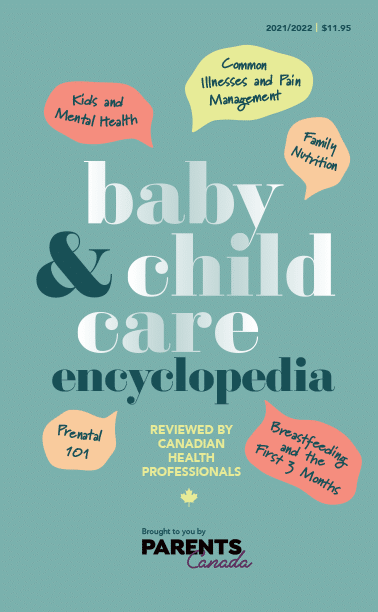Baby
8 min Read
How To Introduce Your Baby To Solids

October 30, 2021
Baby
8 min Read

October 30, 2021

From the pages of the Baby & Child Care Encyclopedia: Chapter 3, Starting Solids and the Toddler Years
W
hen you’re a new parent, life comes at you fast. The age-old saying about babies goes, “The only thing you can count on is change.” Just when you’ve mastered one routine or skill, they hit a growth spurt or learn a new skill and you’re trying to figure out how to adjust your approach to…well, everything from sleep to feeding. And we know you probably don’t want to think about potty training, but it’ll be here before you know it! Read on for expert advice on all things toddler.
Offering solids for the first time might be intimidating, especially with all of the variances between children and the different feeding options available. Babies don’t necessarily hit milestones at the exact same time as their peers, and some might not take to solids as eagerly as others. Not to worry, moms and dads—we’re here to support and guide you every step of the way.
Health Canada currently recommends waiting until your baby is around six months old before introducing solid food (this includes purees). That said, some infants are ready earlier than others, with physical and behavioural indicators happening as early as four months old. Here are some signs to look for before offering those first bites.
If you aren’t sure whether or not your baby is ready for solids, ask your paediatrician or family doctor for advice.
Breastmilk, formula and solid foods aren’t the only nutritional element to be thinking about in that first year or two. Many doctors recommend a daily dose of vitamin D (the recommendation is 400 IU per day up to one year and 600 IU after one year).
Back in the day, it was normal to start with a homemade or store-bought puree that you spoon fed to your child. You know those adorable photos of babies trying peas or carrots for the first time? That was the standard for decades, and it’s still a perfectly acceptable method for feeding your baby.
Another option is baby-led weaning. With this approach, parents offer small amounts of solid food that have been ripped up or cut into appropriate-sized pieces. This might mean slicing blueberries in half, shredding meat, scrambling some egg yolks or offering them a steamed piece of broccoli they can gnaw on. Both puree feeding and baby-led weaning methods have benefits, so it’s really just a matter of preference. You can also try a combination of both feeding types and see what sticks!
According to Canadian medical recommendations, it’s good to start with iron rich foods such as meat, meat alternatives (eggs, tofu, legumes) and/or iron fortified cereals (though there are many iron-rich fruit and veggie options, too). The next step is to expand the list of fruits and vegetables in your baby’s diet. You can offer your baby a slice of ripe pear or avocado, some apple sauce, a steamed slice of carrot or pureed squash—there are plenty of great options!
Milk to drink is typically not recommended until nine months of age or older, and some babies won’t take well to cow’s milk until closer to one year of age (it can be hard on their still-developing gut and lead to gastrointestinal symptoms). If you start your baby on cow’s milk, use 3 percent (homogenized) as they need the higher fat content to keep up with their speedy growth and development. That said, yogurt or cheese can be offered earlier.
Juice is not recommended for babies due to the high sugar content. Many babies will continue to breastfeed or bottle feed while enjoying solid foods. This is normal and a great way to ensure a healthy, wellrounded diet!
If they run in the family or your child has been diagnosed with eczema or asthma, you can ask your doctor about specific strategies for introducing potential allergens. As general advice, you can offer foods containing common allergens (nuts, dairy, wheat, egg, shellfish, etc) as soon as your baby is successfully eating solid foods. In fact, early introduction to these foods may reduce the risk of an allergic reaction. If your child starts to show signs of distress, such as a rash, vomiting, skin discolouration, coughing or wheezing, swelling of the mouth or weakness, call 911. This is a medical emergency.
Making a homemade puree is fairly straightforward if you have the time, the energy and the right tools. However, there are also plenty of wonderful store-bought options to choose from. Do whatever works best for your family. There’s no need for added pressure or guilt!
When buying pre-made baby food from a store, read the label and look for whole ingredients. Avoid anything with salt, added sugars (including maple syrup and honey) or artificial preservatives. If you can’t pronounce it or don’t know what it is, you probably don’t want to feed it to your baby.
If you’re going the homemade route, simply cook and blend your fruit or vegetable of choice. Steaming, roasting and boiling are all good options, and a handheld immersion blender works just as well as a large one. If you’re aiming for a thicker puree with some texture (this works well with older babies who are transitioning from puree to firmer solid foods), you can even use a fork or a potato masher.
Once your baby has gotten used to different flavours and demonstrated no allergic reaction to certain foods, you can start to create blends. (Allergic reactions are sometimes delayed, so to be extra safe, you can wait two or three days between new foods to monitor your baby’s reaction.) Just stick with pure fruit and veggies in those early months—there’s no need for any added salt or sugar. Later on, it may be fun to add subtle flavours like cinnamon to help your baby’s taste buds explore.
Your baby might not react with delight when they try new foods—and that’s okay! It’s perfectly normal for them to make faces or even spit it out. Not only are the flavours new, but compared to breast milk or formula, the textures are a whole other world. Don’t be discouraged—keep offering small, manageable bites. If they only eat a mouthful or get a small taste, that’s totally fine.
When first introducing solids, consider nursing your baby or feeding them a bottle before offering any additional food. This way, your baby won’t be hangry and get frustrated if the solids aren’t exactly what they were after. Let them fill up a bit first in order to enjoy solids at their own pace. You won’t need to do this forever—just until they start eating an adequate amount of solids at mealtimes.
You’ll want to keep mealtime positive and productive, so avoid tricks like “landing the spoon airplane” in your baby’s mouth if your baby isn’t receptive. This could have the opposite effect and create a negative association. Instead, pay attention to your baby’s cues and end mealtime when they become uninterested, displeased with a new food or frustrated. Keep it low pressure, take it day by day and enjoy.
